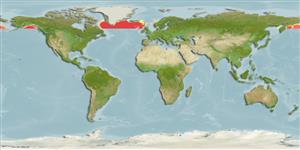Environment: milieu / climate zone / depth range / distribution range
Ecologie
marien bathypelagisch; diepte 500 - 7625 m (Ref. 58426), usually 1200 - 1400 m (Ref. 559). Deep-water; 67°N - 56°N, 180°W - 180°E
Circumglobal: In tropical to temperate waters. Eastern Pacific: ranges from northern California to Peru (Ref. 35600).
Grootte / Gewicht / Leeftijd
Maturity: Lm ? range ? - ? cm
Max length : 100.0 cm TL mannelijk / geslacht onbekend; (Ref. 27000); common length : 55.0 cm NG mannelijk / geslacht onbekend; (Ref. 5755)
Dorsale stekels (totaal): 0; Anale stekels 0. Mouth greatly enlarged by a backward extension of jaws, gape comprising half or more of preanal length; buccal cavity greatly distensible. Tail attenuated and ending in an expanded, luminous caudal organ. Caudal fin absent; scales absent; lateral line without pores, instead with groups of elevated tubules.
Meso- to abyssopelagic (Ref. 58302) and bathypelagic (Ref. 58426). Adults feed mainly on crustaceans, but also take fishes, cephalopods, and other invertebrates (Ref. 2850, 11041). Oviparous, planktonic eggs hatch into planktonic leptocephalus larvae (Ref. 6719, 35600). Degenerative changes in males and females suggest semelparity (Ref. 35600).
Levenscyclus en paargedrag
Maturiteit | Voortplanting | Paaien | Eieren | Fecunditeit | Larven
Oviparous (Ref. 35600). Degenerative changes in males and females suggest semelparity (Ref. 35600). Egg cells within each of the gonads have the same developmental stage (monocyclic ovaries) suggesting only one spawning during its lifetime or periodic spawning (Ref. 36055).
Nielsen, J.G. and E. Bertelsen, 1990. Eurypharyngidae. p. 206. In J.C. Quero, J.C. Hureau, C. Karrer, A. Post and L. Saldanha (eds.) Check-list of the fishes of the eastern tropical Atlantic (CLOFETA). JNICT, Lisbon; SEI, Paris; and UNESCO, Paris. Vol. 1. (Ref. 4457)
Status op de Rode Lijst van het IUCN (Ref. 130435)
Gevaar voor de mens
Harmless
Gebruik door de mens
Visserij: van geen belang
Meer informatie
ReferentiesAquacultuurAquacultuurprofielKweeklijnenGeneticaElectrophoresesErfelijkheidZiektesVerwerkingNutrientsMassaconversie
Tools
Speciale rapporten
Download XML
Internetbronnen
Estimates based on models
Preferred temperature (Ref.
123201): 2.3 - 5.5, mean 3.6 °C (based on 890 cells).
Fylogenetische diversiteitsindex (Ref.
82804): PD
50 = 1.5000 [Uniqueness, from 0.5 = low to 2.0 = high].
Bayesian length-weight: a=0.00102 (0.00046 - 0.00225), b=3.06 (2.88 - 3.24), in cm total length, based on all LWR estimates for this body shape (Ref.
93245).
Trofisch niveau (Ref.
69278): 4.1 ±0.57 se; based on food items.
Weerstandsvermogen (Ref.
120179): Zeer laag, minimale populatieverdubbelingstijd meer dan 14 jaar (Assuming semelparity with tm>10).
Fishing Vulnerability (Ref.
59153): High vulnerability (60 of 100).
Nutrients (Ref.
124155): Calcium = 15.6 [4.0, 64.6] mg/100g; Iron = 0.408 [0.125, 1.243] mg/100g; Protein = 2.94 [0.00, 6.86] %; Omega3 = 0.192 [0.063, 0.599] g/100g; Selenium = 18.7 [6.0, 72.0] μg/100g; VitaminA = 28.8 [3.8, 214.8] μg/100g; Zinc = 0.453 [0.206, 1.092] mg/100g (wet weight);
